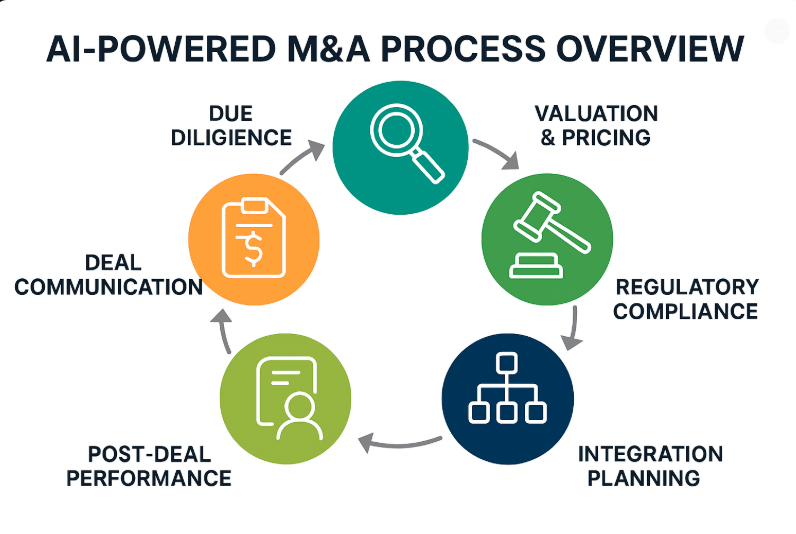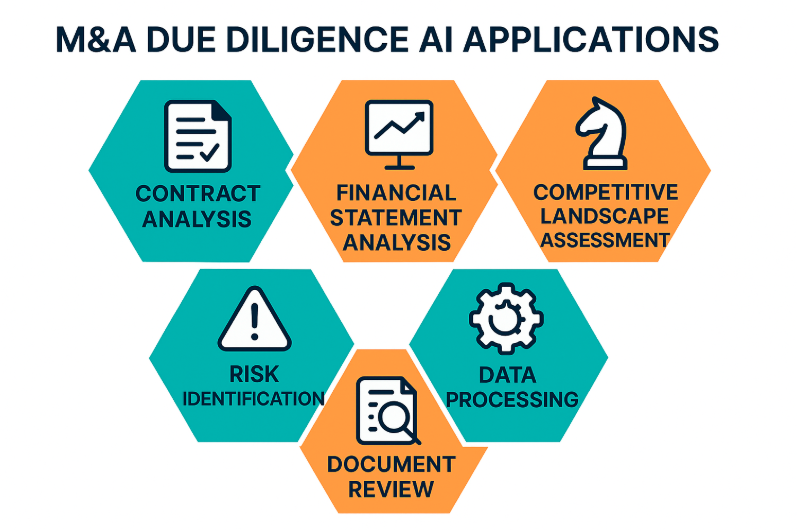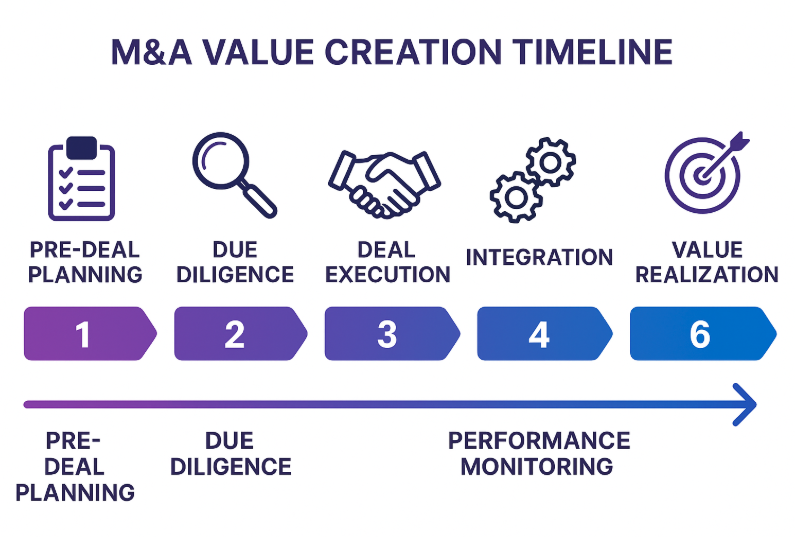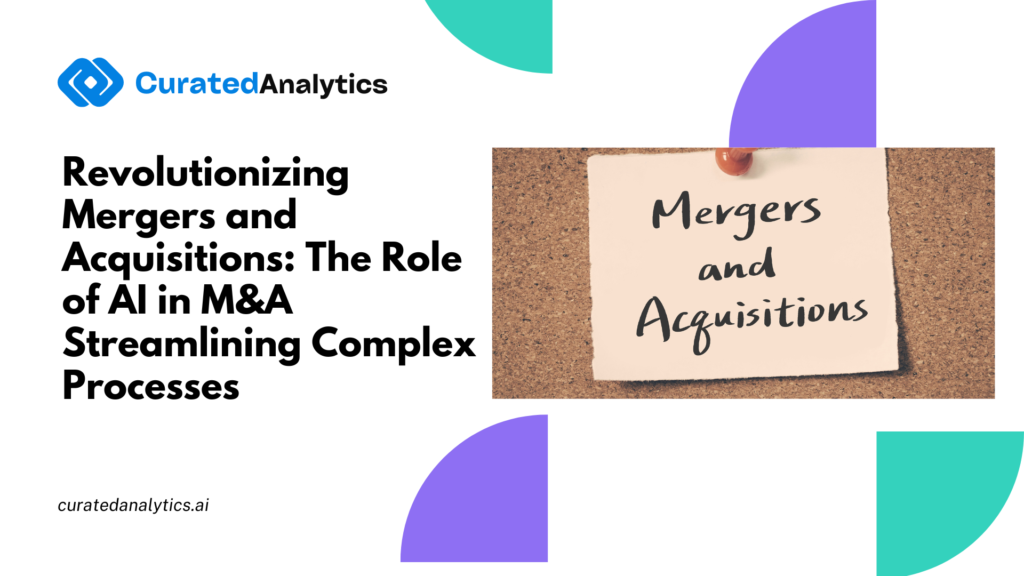Mergers and acquisitions (M&A) are complex, high-stakes transactions that can create significant value but are often fraught with challenges such as high costs, extended timelines, and the risk of failure if not executed properly. The process involves numerous intricate tasks, from due diligence to post-deal integration, which traditionally require substantial manual effort from legal, financial, and operational teams. These tasks can be time-consuming, expensive, and prone to human error, diverting attention from strategic decision-making.
Artificial intelligence (AI) is poised to transform the M&A landscape by automating many of these processes. AI in M&A applications can significantly reduce time-to-completion, improve accuracy, and free up high-value human expertise for strategic initiatives rather than data processing. This article explores how AI can be leveraged to streamline key M&A tasks, making the entire process more efficient and effective.

Due Diligence
Due diligence is the foundation of any M&A transaction, involving a thorough investigation of the target company to uncover potential risks, liabilities, and opportunities. AI can revolutionize this process by automating several critical tasks:
Contract Analysis: Reviewing thousands of contracts manually is a labor-intensive process that can take weeks or months. AI, powered by natural language processing (NLP), can scan and analyze contracts in a fraction of the time. It extracts key terms, obligations, and potential risks, flagging anomalies for human review. This not only accelerates the process but also reduces the risk of oversight.
Financial Statement Analysis: Analyzing years of financial data to detect patterns, anomalies, or accounting irregularities is daunting. AI can process large datasets rapidly, using machine learning algorithms to identify inconsistencies or red flags that may indicate financial mismanagement or fraud. This enhances both the speed and accuracy of financial due diligence.
Competitive Landscape Assessment: Understanding the target’s market position requires synthesizing vast amounts of data. AI can aggregate and analyze market intelligence, news, and social media content to provide a real-time assessment of the competitive environment. This helps acquirers evaluate the strategic fit and identify potential threats or opportunities more effectively.
Understanding how business intelligence and generative AI transform analytics for leaders is crucial for maximizing the value of these due diligence insights.

Valuation & Pricing
Determining the fair value of a target company is a critical yet complex aspect of M&A. AI can enhance valuation and pricing through:
Comparable Company Analysis: Traditionally, identifying comparable companies relies on industry classification, but AI can analyze a broader range of factors—such as business models, growth trajectories, and customer demographics—to find more accurate comparables. This leads to better benchmarking and more precise valuations.
Scenario Modeling: AI can run thousands of financial scenarios in minutes, stress-testing assumptions about market conditions, interest rates, and other variables. This allows dealmakers to understand the full range of possible outcomes and make more informed pricing decisions.
Synergy Identification: AI can analyze operational data from both the acquirer and the target to pinpoint areas where the combined entity can achieve cost savings or revenue enhancements. By quantifying these synergies, AI helps justify the acquisition price and ensures that potential value creation is not overlooked.
Regulatory Compliance
Navigating the regulatory landscape, especially in cross-border transactions, is a complex and critical part of M&A. AI can assist in:
Regulatory Filing Preparation: AI can automate the drafting of preliminary regulatory filings by extracting relevant data from company records and ensuring compliance with specific formats and requirements. This reduces the manual effort required and minimizes errors.
Antitrust Screening: By analyzing market share data, pricing power, and competitive dynamics, AI can assess whether a deal might raise antitrust concerns. Early detection allows companies to address potential issues proactively, avoiding delays or deal blockers.
Compliance Monitoring: AI can continuously monitor regulatory changes across jurisdictions, alerting deal teams to updates that might impact the transaction timeline or structure. This ensures that the deal remains compliant throughout the process.
For organizations looking to implement comprehensive regulatory oversight, AI compliance monitoring provides a complete guide for business leaders navigating complex regulatory environments.
Integration Planning
Successful integration is key to realizing the value of an M&A deal. AI can facilitate this by:
Cultural Compatibility Assessment: AI can analyze internal communications, employee feedback, and social media sentiment to gauge cultural alignment between the two companies. This insight helps design integration strategies that minimize friction and maximize employee engagement.
IT Systems Integration Mapping: AI can automatically map out interdependencies between the IT systems of merging companies, recommending optimal integration approaches to avoid disruptions. This reduces the risk of operational downtime during the integration phase.
Talent Retention Modeling: By analyzing historical data from similar transactions, AI can predict which key employees are at risk of leaving and why. This enables the development of targeted retention strategies, ensuring that critical talent is retained post-deal.
Understanding how to integrate AI with your overall business strategy becomes essential during this phase to ensure seamless organizational alignment.
Deal Communications
Effective communication with stakeholders is crucial throughout the M&A process. AI can enhance this by:
Stakeholder Sentiment Analysis: AI can monitor social media, news outlets, and other channels in real-time to gauge stakeholder reactions, allowing companies to address concerns or misinformation promptly.
Disclosure Document Preparation: AI can draft initial versions of disclosure documents, ensuring consistency and compliance with legal standards. This reduces the burden on legal teams and accelerates the communication process.
Media Monitoring: AI can track media coverage and social media sentiment, providing early warnings of potential reputation risks or public relations issues. This enables proactive management of the deal’s public narrative.
Post-Deal Performance
After the deal closes, it is essential to track whether the expected benefits are being realized. AI can assist in:

Integration Milestone Tracking: AI can automatically monitor progress against integration milestones, flagging delays or issues that require attention. This ensures that the integration stays on track and objectives are met.
Synergy Realization Verification: By analyzing financial and operational data, AI can confirm whether projected synergies, such as cost savings or revenue growth, are materializing as expected. This provides an objective measure of the deal’s success.
Long-Term Value Creation Assessment: AI can evaluate key performance indicators over time to determine if the strategic rationale for the deal is being achieved, such as increased market share or enhanced innovation capabilities. This helps stakeholders assess the long-term impact of the transaction.
Organizations looking to establish proper measurement frameworks should consider how to create a business case for an enterprise AI project to ensure ROI tracking and value realization.
Conclusion
AI has the potential to revolutionize the M&A process by automating time-consuming tasks, improving accuracy, and enabling human experts to focus on high-level strategic decisions. From due diligence to post-deal integration, AI can streamline every phase of the transaction, reducing costs and increasing the likelihood of success. As AI technology continues to evolve, its role in M&A is likely to expand, offering even more sophisticated tools for dealmakers.
However, while AI can greatly enhance efficiency, it is important to remember that human judgment remains irreplaceable in areas requiring strategic insight, negotiation, and relationship management. The future of M&A will likely see AI and human expertise working in tandem to achieve optimal outcomes.
Ready to explore how AI can transform your M&A processes? Contact Curated Analytics to discover how we can help you implement intelligent automation solutions that streamline complex transactions and deliver measurable business value.
Frequently Asked Questions
Q: How can AI improve M&A due diligence processes?
A: AI revolutionizes due diligence through automated contract analysis using natural language processing, rapid financial statement analysis to detect anomalies and fraud indicators, and competitive landscape assessment by synthesizing market intelligence, news, and social media content for real-time market positioning insights.
Q: What role does AI play in M&A valuation and pricing?
A: AI enhances valuation through more accurate comparable company analysis by examining business models and growth trajectories, scenario modeling that runs thousands of financial scenarios in minutes, and synergy identification by analyzing operational data to quantify cost savings and revenue enhancement opportunities.
Q: How does AI assist with regulatory compliance in M&A transactions?
A: AI supports regulatory compliance by automating preliminary regulatory filing preparation, conducting antitrust screening through market share and competitive dynamics analysis, and providing continuous compliance monitoring across jurisdictions to alert teams of regulatory changes that might impact transactions.
Q: What are the key benefits of using AI in M&A integration planning?
A: AI facilitates integration through cultural compatibility assessment by analyzing communications and sentiment, IT systems integration mapping to recommend optimal approaches and avoid disruptions, and talent retention modeling to predict employee flight risk and develop targeted retention strategies.
Q: How can AI help track post-deal performance in M&A transactions?
A: AI assists post-deal tracking through automated integration milestone monitoring, synergy realization verification by analyzing financial and operational data, and long-term value creation assessment by evaluating key performance indicators to determine if strategic rationale is being achieved.

